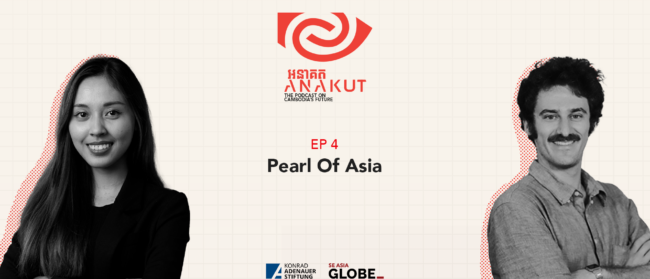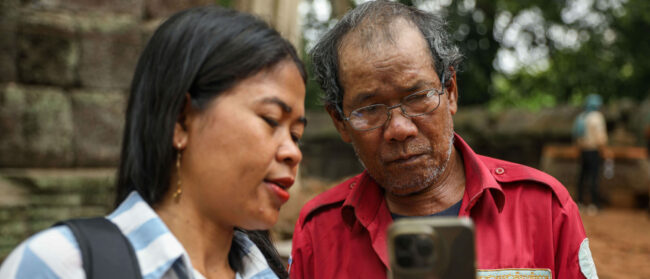It was the late 90s when Hok Kang first touched down in Singapore while tagging along on a business trip with his dad. The city-state’s beautiful parks, well-charted streets and modern architecture overwhelmed him. This was the first time the teenager had stepped inside buildings that had a holistic design – a design that felt welcoming.
Landing back down in Phnom Penh, Hok returned to his dingy bedroom in a shop house. When he speaks about typical Cambodian shop houses’ cookie-cutter blueprints, his tone changes, as if describing them is a chore: “It’s 4 meters by 20 meters. There’s no light in the middle. It’s one whole line to get maximum efficiency. You go inside. After 5 meters, it’s dark, in the back, blocked. So there’s no light, there’s no ventilation, and you do business on the ground floor and you live upstairs.”
In the air condition-less 90s, a fan would whirl the same sticky, recycled air through his bedroom in the centre of the house, where the only light came secondhand through his window that looked out onto the living room. Downstairs, the front end of the house served as his dad’s shop during the day, an eating area at dinnertime and a parking spot for the family’s motorbikes at night.

Hok is explaining this from his own office in Cambodia’s first “boutique office space”, Raintree. The scene he describes couldn’t be much more different from where he sits now. Fresh sunlight pours through an expansive plant-lined window while a glass wall on the other side of the room separates him from an open floor plan of desks outside. He’s the co-founding architect behind Raintree, created by UrbanLand, the award-winning real estate development company Hok founded in 2013. But Hok’s CV runs longer. He’s also a founding partner in Cambodia’s revered Brown Coffee, which has 18 locations, all of which Hok designed and developed through his first entrepreneurial venture as founder of Hok Kang Architects (HKA).
He traces these successes back to that childhood trip to Singapore, when he decided he would learn how to bring beautiful architecture to his own country. After finishing high school, Hok returned to Singapore for four years to do general studies as a member of the first batch of Asean scholars to the country. His English was poor, but Hok was determined to learn so he could study architecture in the US. In his free time, he would pore over books, checking the dictionary for the meaning of the roughly 15 words per page that he didn’t understand. From there, he went to Washington University in the US, double-majoring in architecture and entrepreneurship.
Hok pulls out a campus magazine that interviewed him before his 2009 graduation from Washington University and reads the quote it published from him: “I plan to start an architecture firm in Phnom Penh whose practicing philosophy takes careful consideration of the local context, culture, tradition and rich ancient heritage.”
“It’s almost my vision come to life, actually,” he says of UrbanLand.
Before Hok moved back to Phnom Penh, he and five cousins decided to create a coffee store so Cambodians would have a place to come together – something he said the city was lacking previously. “I studied architecture, so I said, ‘Guys, don’t worry about design, I am gonna be fresh out of college soon.’” From there, he found a property and began making renovation plans that would transform the building into the first Brown Coffee location. This was also the start of HKA, which claimed the building’s attic as its headquarters, host to Hok and founding partner Chanritthy San.
But while Hok had free range on designing the architecture for each Brown location, he became flustered by the limitations clients would put on his work in other projects. Rather than invest in valuable architectural elements like airflow and light, clients would ask to replicate other simple building designs to keep costs low.
“They say, ‘Hok, I like this house a lot, can you help me design something similar?’ To that I say, ‘If you already know what you want, why come to me? Why try to imitate what’s here already?’” he says. “It’s quite frustrating because a lot of people don’t see what architecture can do. It’s like, ‘My friend built this, I’ll build something similar.’ So, the frustration really turned into the urge to build something myself. I said, you know what – to really show people that architecture matters and that architecture makes an impact, I’ll just venture into real estate development and I’ll build it myself.”
Just as he had with Brown and HKA, five years ago Hok decided to venture into a new challenge, teaching himself along the way. He convinced his siblings and mum to help him buy up a seven-digit plot of land in central Phnom Penh to develop, and then began his first real estate project.
“I said, ‘give me some seed funding, just buy me a piece of land and I will design it to hell,’” he says. “I bought that land and just designed it day and night until I got it right. That’s when you realise that there are so many things involved in the design, construction and sale of the building, and no matter how hard you work, there’s a steep learning curve.”
“Say yes first and figure out how to do it later,” he says bluntly about overcoming this. “I just jumped into it, and if you asked me to jump now, I would not do it. And I’m glad that I jumped five years ago.”
With that jump, Hok also had to convince talented professionals to abandon their chosen career paths for his ambitious vision, which he says was a struggle early on.
“We started with a vision to create aspirational spaces for the community, to make change. That’s our vision,” he says. “It’s something that people haven’t seen before, it’s something that has the extra X-factor. So, if it’s something that people haven’t seen before, how would they trust you? Trying to convince people from just the floor plan, from just that, is a challenge.”
I said, ‘give me some seed funding, just buy me a piece of land and I will design it to hell
The precedent HKA set for his work helped him overcome this, and UrbanLand now has 30 staff while HKA employs 26. Reflecting on his accomplishments over the past decade, Hok lets out a laugh and says, “I would say I’m doing okay.”
UrbanLand’s first plot of land became Embassy Residences, a boutique condominium that took Best Condo Development and Best Residential Architectural Design at the 2016 Cambodia Property Awards. From there, Hok partnered with Zoë Ng to co-found Raintree, which was completed in 2017 and won Best Office Development in Cambodia at the 2017-2018 International Property Awards. In October, UrbanLand plans to unveil a Siem Reap hotel called Treeline, followed in the first quarter of next year by the Embassy Central condominium in Phnom Penh – which already won Best Residential Architectural Design at the 2016 Cambodia Property Awards.
Each site has its own style, geared towards the “user experience inside out”, says Hok. There are grounding principles that guide each one. UrbanLand focuses on sustainability in sourcing materials, whether that means sourcing mountain stones from Preah Vihear or using local wood; building in context by using materials and techniques that accommodate the six months of monsoons and the other half of the year swallowed by dry heat; and being green-minded, both in terms of sprucing up sites with plants and using sustainable technology.
Hok says other developers have attempted to replicate UrbanLand’s work. “But that’s okay, that’s good,” he says. It means more people will escape the confines of the shop houses that inspired him to become an architect.
“When you make aspirational space and people emulate you, then you have more potential to impact, to make change, because you allow others to come with you. That’s what we’re interested in at UrbanLand.”


